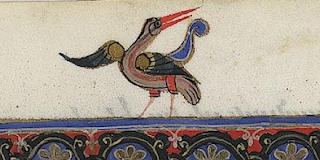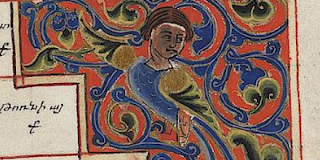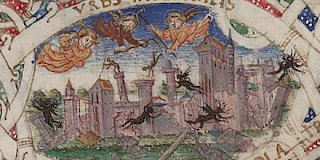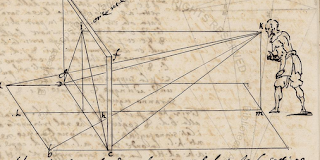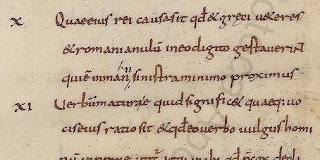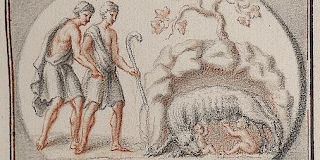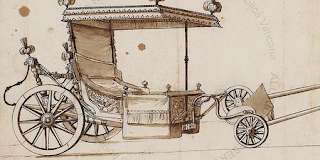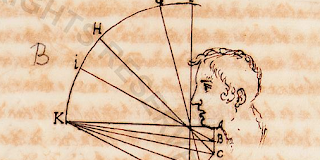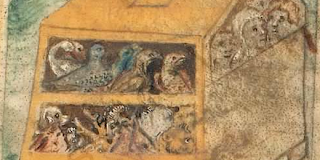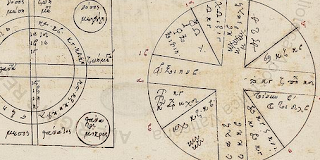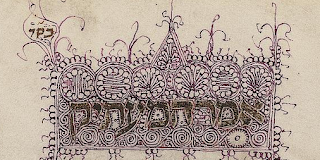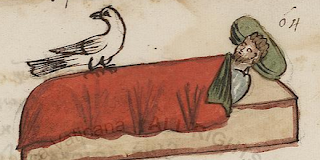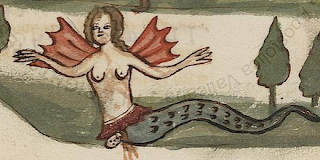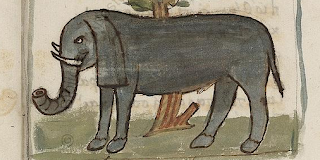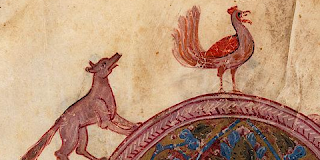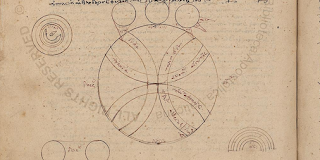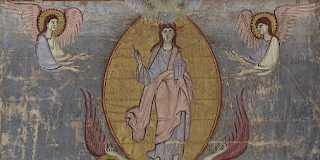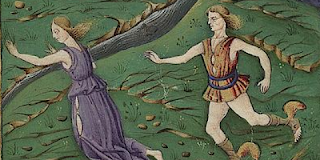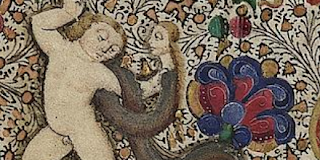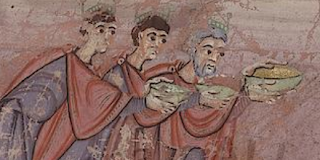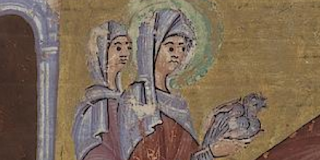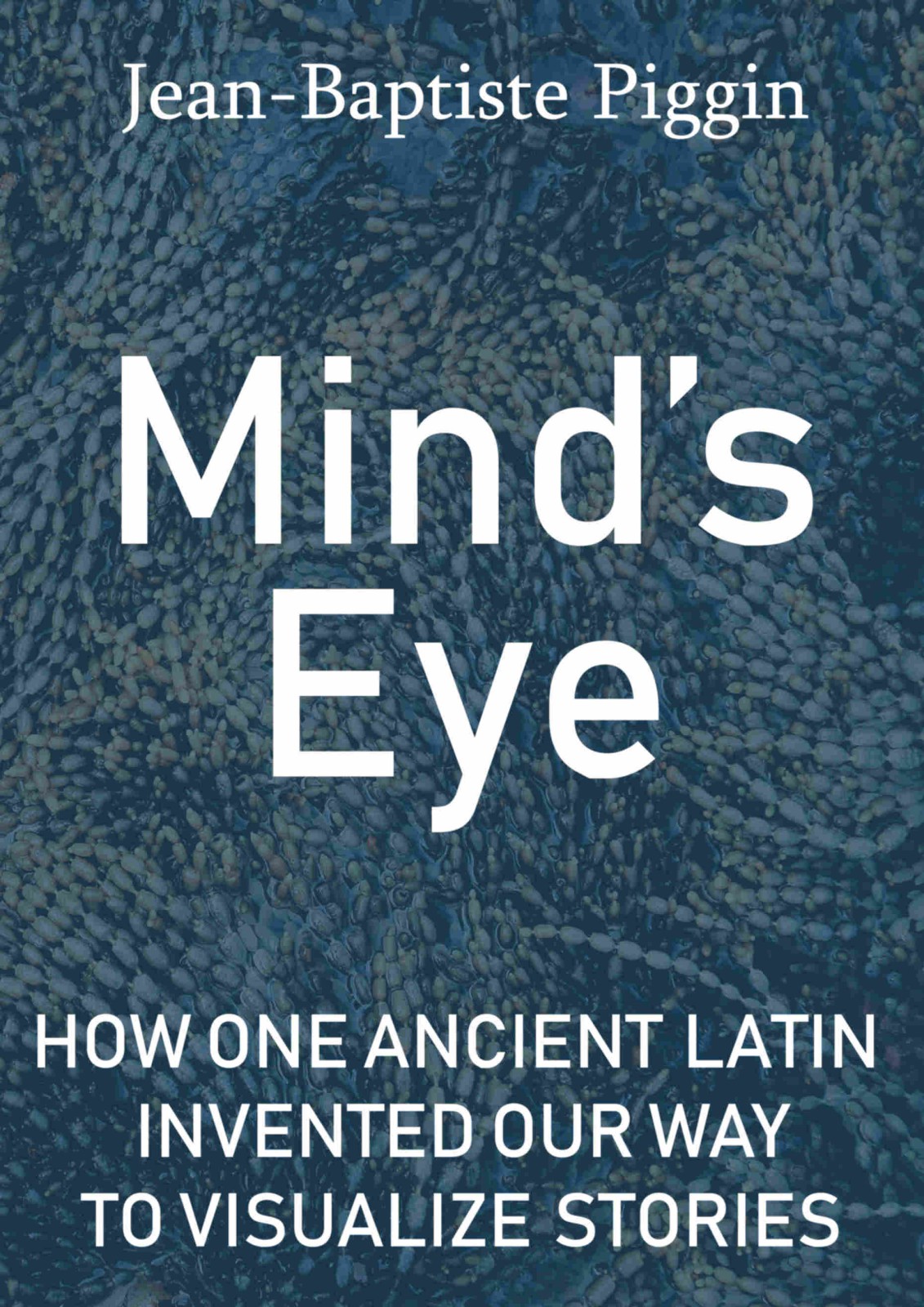That's why we should be so pleased that a new crop of digitizations and uploadings at Digita Vaticana includes Vat.arm.3, a finely illuminated 13th-century codex that is believed to have been the first Armenian manuscript to enter the Vatican book collections in the 15th century. This was exhibited in the Rome Reborn exhibition 20 years ago in Washington and St Louis and the catalog stated that it was thought to have been donated to the papacy by the Armenian delegates at the Council of Florence.
Its texts are mainly liturgical but there are also texts on chronology, geography, astronomy, mensuration, philosophy and history. I'm not aware if any of these are unique, but it's great to just browse this thick codex and admire the care with which it was made. From the illuminations, here is a fine red-beaked bird from folio 213r:
There's also a fine bird lady on folio 317r as part of what seems to be a matrix of consanguines or arbor consanguinatis:
The digitizations are evidently advancing despite the summer heat in Rome. The latest 51 bring the tally of items on the index page to 2,633. Here is my list:
- Borg.copt.109.cass.I.fasc.1,
- Borgh.262, Decretales of Pope Gregory IX, glossed by Bernardus Parmensis (also known as Bernard of Parma, Bernard Botone, Bernard Bottoni), seems similar to Ms. 1 at Syracuse University
- Borgh.366, Augustine of Hippo, City of God, 15th-century manuscript
- Cappon.132, handwritten copy from about 1730 of an earlier treatise on perspective drawing by the mannerist painter Giulio Romano (see below). Consult the catalog at Archive.org for more information about this and other Capponi items below.
- Cappon.179,
- Cappon.182,
- Cappon.198,
- Cappon.203,
- Cappon.223,
- Cappon.226,
- Cappon.227,
- Cappon.230,
- Cappon.236,
- Cappon.256,
- Cappon.257,
- Cappon.262,
- Cappon.263,
- Cappon.265,
- Cappon.266,
- Cappon.267,
- Cappon.268,
- Cappon.274,
- Cappon.280.pt.1,
- Cappon.280.pt.2,
- Cappon.291.pt.1,
- Cappon.294,
- Cappon.299,
- Cappon.304,
- Cappon.305,
- Cappon.310,
- Cappon.311,
- Cappon.314,
- Cappon.315,
- Cappon.316,
- Cappon.317,
- Reg.lat.1360, a manuscript of the 12th-century Chanson d'Aspremont, a French narrative poem of heroic deeds (Wikipedia)
- Sbath.723, one of the Arabic manuscripts collected by Paul Sbath of Aleppo, Syria
- Urb.lat.4, concordance of the Bible, 15th century
- Urb.lat.8, Joachim of Fiore, Thomas Aquinas, Lawrence of Pratis, 15th-century ms
- Vat.arm.3, Eusebius' Epistle to Carpianus, and other texts, featured in Rome Reborn (see above)
- Vat.ebr.116, Talmud Bavli, Tract Bava Kamma
- Vat.ebr.140, part of the Babylonian Talmud (thanks to @TuomasLevanen for these 2 notes)
- Vat.lat.65, Numbers, Deuteronomy, Judges, glossed
- Vat.lat.110, commentary on Ecclesiasticus, palimpsest layer apparently includes some 7th-century (?) material from Pliny the Elder
- Vat.lat.143, Lanfranc of Canterbury, commentary on Pauline Epistles
- Vat.lat.146, Peter Lombard on Pauline Epistles, 14th century
- Vat.lat.172, Dionysius Areopagita
- Vat.lat.1895, Diogenes Laertius
- Vat.lat.2878, 15th-century, humanist copy of Cicero's Epistulae ad Atticum (discussed by Peter Lebrecht Schmidt). The front of this codex was abused for a bit of papal bookkeeping, being used to record a mule-leasing agreement: Astolfo, superintendent of mules of the palace, must deliver on 1 January 1570 to Bernardino Cirillo, preceptor of the Hospital of the Holy Spirit and the pope's majordomo, and take back into custody on the 31st of the same month, all those mules on the attached inventory in the stable of the palace (the actual inventory of the mules is not there, which would have been too much of an insult to Cicero and Atticus).
- Vat.lat.6549, Henry of Bourbon (apparently Henry IV of France who issued the Edict of Nantes), paper manuscript
- Vat.lat.14153, Italian literary autographs
Here is a drawing of devils flying around evil idolatrous Rome from Borgh.366, folio 1r
Angles of view in treatise on perspective drawing, Cappon 132, folio 14v:
By the way, a knowledge of medieval Armenian is something that certain scholars brag about, much as a scratch golfer would brag of his zero handicap. A few weeks back, a reviewer for the Bryn Mawr Classical Review was publicly berating any of his inferiors having the temerity to write about Philo without learning Armenian first: The language barrier is not unsurmountable and does not justify studying this part of Philo from the translations of the (Armenian) translation only. That sounds a bit like those ads that claim that anyone can learn to play golf like Tiger Woods if they buy this or that set of clubs. Sigh. If only life were that easy.
